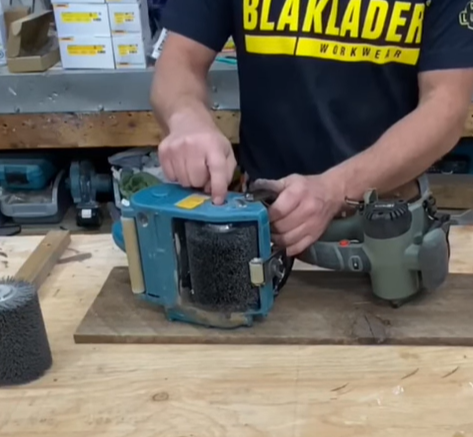As a reclaimed timber woodworker I use wire brush machines to clean up barn wood before it goes into processing. I need them to get down into the grooves and cracks, removing the years of gunk built up from farm activity and weather. I do not want them to sand the boards down at this stage of the process as I like to leave lots of character.
When I’m demolishing buildings and fences on local farms, I specifically look for wood pieces that have circular and bandsaw marks that can add the character and personality that my customers love.

As we look at these two machines, I want to compare the key differences and factors that would affect which one you would want to invest in.

PRICE
Makita – More expensive.
Restorer – More budget friendly.

WHEEL and BRUSHES
Makita – Bigger wheel. It comes with a few options for brushes, I use the wire and nylon as I mostly work with wood. Exchanging brushes can be a bit finnicky as you need to lie the machine on its side, pull a long pin out, swap out brushes, and sometimes must jiggle the pin back into alignment, then you tighten it all back up.
Restorer – Smaller wheel. There are many options for brushes including wire, stainless steel, striping material, flapper sandpaper, light and heavy polishing, sanding and more. Exchanging brushes is as easy as opening a cover and switching the brushes, like a battery pack.


EASE OF USE
Makita – At the back of this machine there is a ride wheel which allows you to slowly pivot the machine to ease the brush into engagement with the wood. It also has a max depth setting adjustable wheel on the front, which comes in handy when trying to do more delicate work.
Restorer – The user is completely responsible for the depth and connection with the product, so a close watch is necessary while working.

LOCATION OF DUST PORT
Makita – Near the top. I do not like this as much, as dust flies around inside the machine and has to change directions and to go out the other side. It can be quite messy and unpleasant.
Restorer – On the back. I feel this is a more intuitive place to put it as the dust does not interfere with your work.

HANDLE
Makita – Has larger handle opening. The rear handle is tilted so it can put my wrist at an awkward angle, but this leaves an option to hold the handle at the back like a hand saw. The front handle is like holding on to a vibrating metal bar. If you are not wearing work gloves it can get slippery.
Restorer – Is a little more ergonomic in how you hold it, which to me seems less exhausting to use. The rear hand is tilted downward putting my wrist in a more natural and comfortable alignment. The front handle is like the horn of a horse saddle. A big bonus for me is that BOTH handles have some padded material! Plus, this machine has a speed adjustment which is more friendly on your hands.

MOTOR
Makita – 7.8 amp motor / 3500 revolutions per minute. When you use this machine, you have to hold on REAL tight, it will take you for a ride. It can chew through product real fast!
Restorer – 3.5 amp motor / can adjust speed between 1000 – 3200 revolutions per minute. This also gives you a workout, but you would physically last longer on larger projects.
There you have it! I started with the Makita and added the Restorer to my shop. I have used both many times on different kinds of wood with spectacular results.
My personal recommendation based on cost analysis, ergonomic shape, dust port location, brush options, and overall design is the RESTORER.

